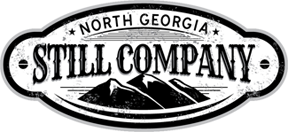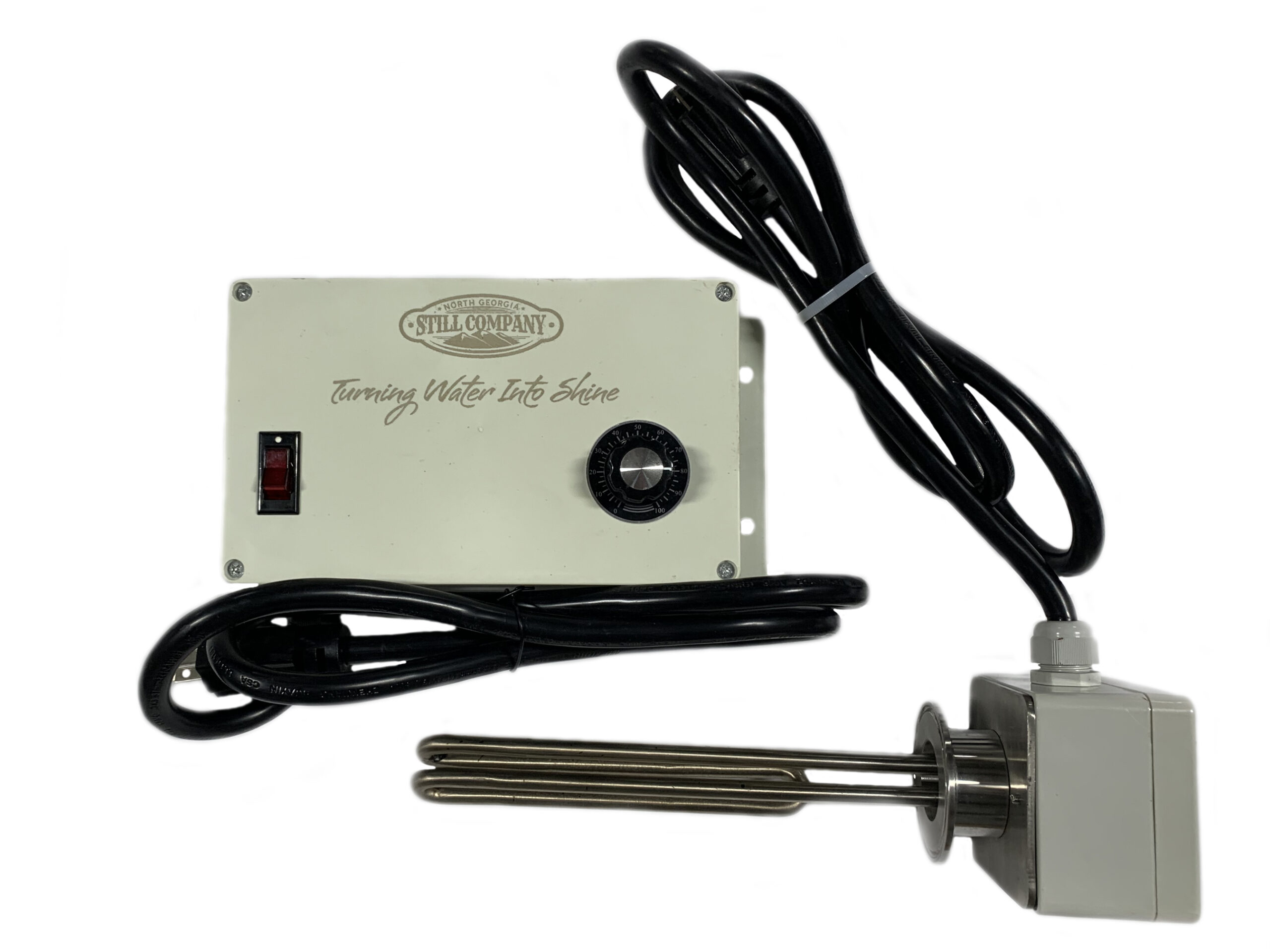Electric Elements on a Moonshine Still – Basic Considerations
It is my belief that there has never been a better time to be a hobby distiller. The options in equipment, resources, and even ingredients, are plentiful!
As hobby distillers and moonshiners move into the modern era, many things have stayed the same. But not everything. There have been a number of huge advancements in techniques, practices, and equipment. Electric heating solutions are one of those advancements.
While many people still use an open flame, we have come a long way from using a wood fire to power our beloved liquor makers. Step into the present. Almost 100 years since prohibition, and the use of electric heating methods is common. By far the most popular electric solution is internal heating elements. These elements are generally paired with a voltage controller, or PID. These controllers are incredibly precise and effective, giving you perfect control over your still.
As the popularity of electric heat picks up, many people are converting their gas / wood fired stills.
It’s not as simple as just slapping an element port on your still though. Careful thought should be placed on the location of your port(s), as well as the size of the heating element(s) needed. Depending on the size of your still and how much power you will need, you may need one or two ports (or even more).
For simplicity, lets cover single and dual elements. For the most part we will be laying it out in generalities. There are always exceptions to the rules.
In general, these are the four most common electric setups-
110V 2000w (single element) – Max pot sizes: 10-12 gallons
110V 4000w (dual elements) – Max pot sizes: 20-25 gallons
220v 55000w (single element) – Max pot sizes: 30-35 gallons
220v 11000w (dual elements) – Max pot sizes: 55-70 gallons
Again, there may be exceptions, but usually pushing past these parameters creates long heat up times, and overall pushes past the limits of the power input to your still. The above is the largest still sizes I would personally want to run with those electric systems.
You can see there is some overlap with the above element sizes.
For example: a 5500w element can run a 10 gallon still no problem. The 5500w is definitely more power than is needed, however if you plan to eventually run a larger still, it may be worth considering. The upfront cost of 5500w will be more than the 2000w but could save you money in the long run. 110v setups are usually cheaper, and easier to set up. Most simply plug into the outlets in your home. 220v setups will usually require being hard wired or having a 220v outlet installed (although some can plug into the dryer outlet, distance from your still site is a considerable factor).
The next consideration when going electric, element port location.
Again, because of the unlimited number of factors, these are generalities. The size and dimensions of your still will play a very large role here. Not only will you want to consider element lengths (long elements may not fit in skinnier stills!), but you’ll also want to consider the dimensions of your still (which affects where the liquid levels will be).
In my opinion there is a sweet spot. I want my elements as high off the bottom of my pot as possible. This will help prevent scorching in the event I have any sediment in my wash. But, not too high. I also want the element low enough that I have the ability to run the still at half capacity. When using an electric still (any still really, but especially electric) you want to always be aware of the liquid level in your pot. Running an element dry will not only damage your elements but can be catastrophic. Remember as your still is running, the liquid level will decrease.
Example: If you have a 10 gallon pot, with 10 gallons of 10% ABV wash, you will lose about 1-1.5 gallons. ***This is an oversimplification. Many factors go into determining how much you will collect (Still efficiency, the point when you stop collecting, etc.)***
Knowing your still, the dimensions of your pot, and mash ABV will help you understand where your liquid levels will start and end.
With the factors described above, this usually puts our port location at the top of the lower 1/3 portion of our pot for a single element still. That is high enough to prevent scorching, and low enough you can safely run the still at half capacity.
If a still requires dual elements the same concept applies. The only difference being- I want to space the elements apart as much as I can, without getting too close to the bottom, or being placed too high.
Depending on the dimensions and size of your pot, you may have some wiggle room. You may be able to place the top element a little higher than usual. The dimensions of our Fat 50 gallon pot, and standard 50 gallon pot are very different. Because of this, the elements’ locations are very different.
Spacing the elements apart allows the still to heat more evenly and efficiently.
For example: on any still with dual elements that we build, we place the elements in a way that both elements heat the still efficiently and evenly when running a full pot, while still giving us plenty of liquid coverage. The top element is a little higher than we would normally place it compared to a still with a single element. This gives us a nice even spread of heat. When running only half full, the top element can be removed, and the still can be powered by the bottom element, giving us the best of both worlds. When a still is only half full, we should no longer need the power of an additional element,
The last consideration with heating elements is the way they connect to your pot. There are two ways. threaded into the pot, or by way of a tri clamp connection. Always use a tri clamp if you can. They even make copper tri clamp ferrules now so the DIY folks have an easier time soldering their port in place. It is a million times easier to pull elements in and out when using a tri clamp. This makes setting up, breaking down, and overall maintenance much more enjoyable.
For those who already have threaded elements, there are adapters to convert to tri clamp. Anyone who has used both will tell you that tri clamp is the way to go.
In conclusion, electric heating is only going to continue to become more popular. As of writing this, I would estimate 30%-40% of the stills we build are electric. When we first started running stills, we used propane. We would drag out the burner, lug out a bunch of cinder blocks to build a base, and it worked well. We eventually decided to try running electric. We haven’t run propane on a single one of our stills since. The ease of setup. The precision control of heat. The safety benefits. Electric even gives you the ability to run indoors in the A.C. if you want! The only downside to electric is the initial cost. If you run your still regularly though, that initial investment will pretty quickly pay for itself.
Cheers!
-Andrew Warneke
Co-owner of North Georgia Still Company and lead fabricator
Thoughts and opinions expressed in this article are that of the author ONLY and are not representative of any business, entity or individual listed therein.


Great read, I’m really thinking about converting my keg set up to electric. The costs of propane, and having to run outside while getting eaten alive by mosquitoes are enough to tip the scales alone. But, I thoroughly enjoyed your explanation and breakdown. Keep up the good work 🤘 Shine on
Absolutely! The ability to run indoors is worth it alone! Especially if you’re a year-round shiner. Gets you out of the heat, the cold, etc.
And if you want to run outside in the fall, all you need is an extension cord! It’s definitely worth considering though. Unless the power grid goes out, I’ll likely never run propane again. There are some really good instructions out there for those who want to build their own controller too.
Good info, I build controllers, I use 150 watts per gallon as a guideline. We are very close. Wire size is very important also for the buyer. That would be an article in itself. I’m a automation electrician for a large auto industry supplier in Tennessee.
Just read your comment on controllers. I’m looking at a 10 gallon still and would like to use a 1500w element. If you can could you give me a price for a controller? Thanks
Great information! I understand it’s critical not to run an internal element without it being immersed in fluid. In that case, if one did a stripping run and ended up with a smaller volume (as is the point!) then how do you make sure you have enough volume when you do the spirit run to keep the element covered? I know some say to proof the low wines to at most 40% but it seems strange to add water back when you just distilled to remove the water to produce the low wines. If that’s what you have to do to not ruin the element, can you proof it down as low as you want to make sure the the element remains covered in fluid even at the end of your spirit run, given that you’ll reduce the volume in the spirit run considerably when it finishes?
I’m a bit confused as to how to make this work.
I understand it’s critical for one to not run an internal element without it being immersed in fluid. In that case, if one did a stripping run and ended up with a smaller volume (as is the point!) then how should they make sure to have enough volume when they do the spirit run to keep the element covered? I know some say to proof the low wines to at most 40% but it seems strange to add water back when it was just distilled to remove the water. If that’s what they have to do to not ruin the element, can they proof it down as low as they want to make sure the the element remains covered in fluid even at the end of their spirit run, given that they’ll reduce the volume in the spirit run considerably when it finishes?
40% Is the highest you want in the still for safety concerns. Much higher and you are loading a flammable liquid. Obviously you don’t want that. You can proof it down as low as you want/need, but most folks will do multiple stripping runs in order to gather a significant amount of low wines. That way you don’t have to proof down too low. Another thing you can do is take your low wines and mix that into another wash.